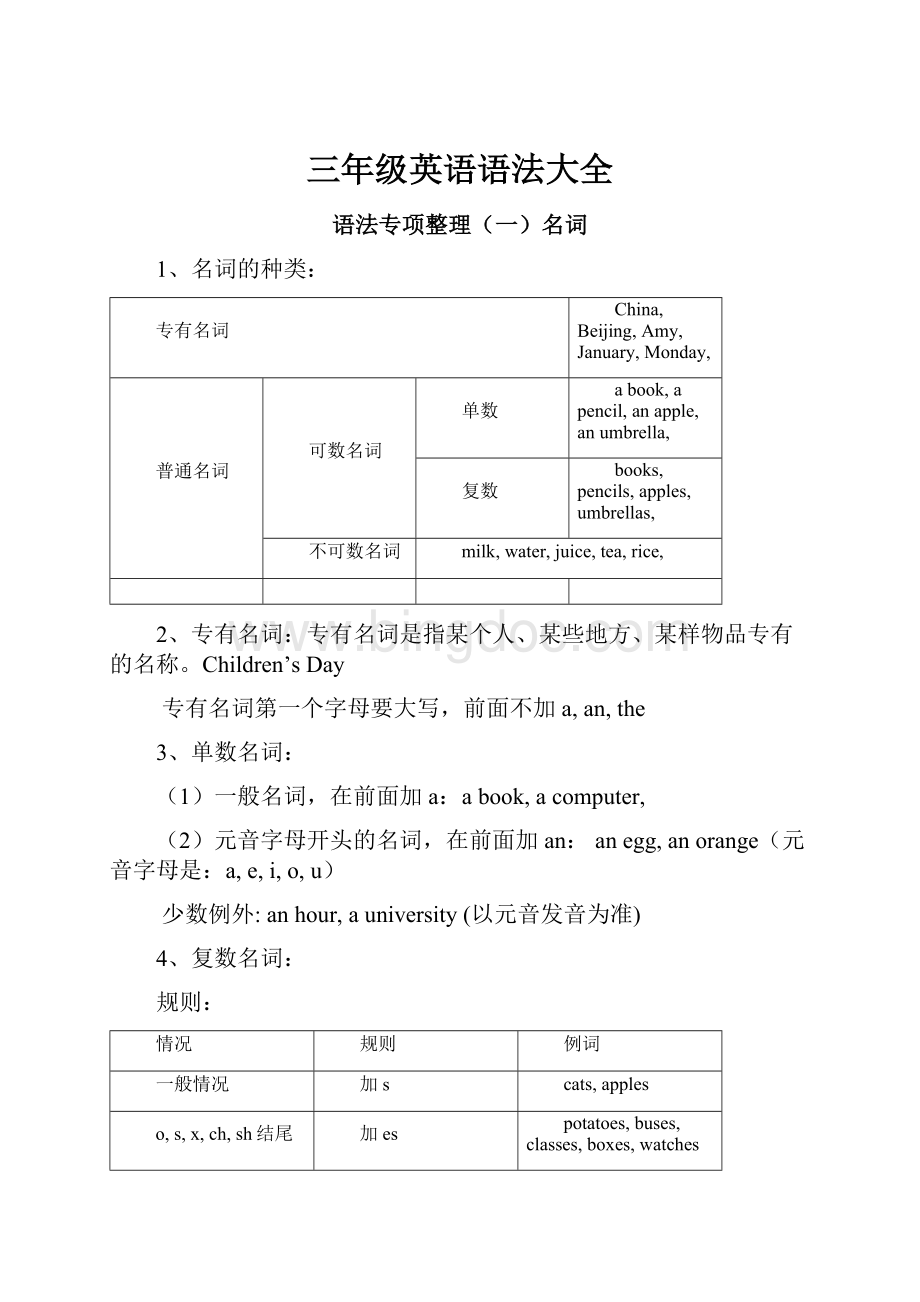三年级英语语法大全Word文档下载推荐.docx
《三年级英语语法大全Word文档下载推荐.docx》由会员分享,可在线阅读,更多相关《三年级英语语法大全Word文档下载推荐.docx(12页珍藏版)》请在冰点文库上搜索。

不规则:
改变元音
foot--feet,tooth--teeth,goose--geese,man--men,woman--women,
词尾发生变化
child—children,mouse--mice
单复数同形
sheep--sheep,deer--deer,fish--fish,people--people
5、不可数名词:
在不可数名词前只能加some(一些),much(许多)
(1)液体:
water,milk,coke,coffee,juice,tea
(2)气体:
air,vapour
(3)不能“个别的”存在:
hair,rice,beef,meat,pork,mutton
语法专项整理
(二)代词
1、人称代词
人称
单数
复数
主格
宾格
第一人称
I
me
we
us
第二人称
you
第三人称
he
him
they
them
she
her
it
2、物主代词
形容词性
名词性
my
mine
our
ours
your
yours
his
their
theirs
hers
its
3、指示代词:
this,that,these,those
如:
Thisismydoll.ThatisMary’s.
Lookatthethosesheep.Theyareeatinggrass.
语法专项整理(三)数词
1、基数词:
表示数目的多少
one
onehundred
two
twenty
onethousand
three
thirteen
thirty
三位数要在百位和十位之间加and
如:
onehundredandsixteen116
onehundredandtwenty-one121
four
fourteen
forty
five
fifteen
fifty
six
sixteen
sixty
severn
seventeen
seventy
eight
eighteen
eighty
nine
nineteen
ninety
ten
加teen
加ty
两位数(非整十)中间加连字符“-”
fifty-one51
eleven
twelve
2、序数词:
表示顺序
第一至第十
第十一至第十九
第二十及以上
first
eleventh
second
twelfth
twentieth
third
thirteenth
thirtieth
fourth
fourteenth
fortieth
fifth
fifteenth
fiftieth
sixth
sixteenth
sixtieth
seventh
seventeenth
seventieth
eighth
eighteenth
eightieth
ninth
nineteenth
ninetieth
tenth
除第1、2、3,直接加th
ty结尾,变y为ie,再加th
语法专项整理(五)介词
1、介词的分类
词类
时间介词
at7:
00,inthemorning,onMonday,beforelunch,afterdinner,
方位介词
onthedesk,inthepark,athome,underthetree,behindthedoor,overthebed,infrontofthehouse,nearthelake,nexttothecinema,
动向介词
gotoschool,jumpintothewater,climbupthetree,skidownthemountain,runoutofthedoor
方式介词
bybike,onfoot,playwithmyfriend
2、at,on,in在表示时间时的区别:
(1)at用于具体的时刻:
at10:
05,atnoon,atnight,
(2)on用于具体的一天(常与星期、节日、具体的某一天连用,也表示某天上午、下午或晚上):
onMonday,onNewYear’sDay,onJune1st,onmybirthday,onFridaymorning,ontheweekend,
(3)in用于某一段时间(常与上午、下午、晚上连用,常与月份、季节、年份连用):
inthemorning,intheafternoon,intheevening,inMarch,inspring,in2007,
语法专项整理(六)Therebe结构
1、概念:
Therebe结构又叫存在句,表示某地存在某物。
2、Therebe结构的肯定句
(1)Thereis+可数名词单数+地点:
Thereisabookonthedesk.
(2)Thereis+不可数名词+地点:
Thereissomewaterintheglass
(3)Thereare+可数名词复数+地点:
Therearesomeflowersinthegarden.
●就近原则:
若句子中有几个并列的主语,be动词的形式和最近的一个主语保持一致
Thereisabookand2pencilsinthebag.
Therearemanyflowersandatreeinthegarden.
3、Therebe结构的疑问句(把be动词提到句子前面,若句子中有some,要变为any)
Isthereabookonthedesk?
Isthereanywaterintheglass?
Arethereanyflowersinthegarden?
语法专项整理(七)现在进行时
1、概念:
表示说话时正在进行的动作。
(提示词:
Now,look,listen)
2、构成:
be动词+现在分词:
be动词后面的动词要加ing,变成动名词。
形式
例句
第一人称单数+am+现在分词
Iamreadingabook.
第三人称单数+is+现在分词
Heisdoinghomework.Sheisflyingakite.
第二人称单数/各人称复数+are+现在分词
Wearecookingdinner.Theyarecleaningtheroom.
3、现在分词
一般情况,加ing
Walk-walking,do-doing
e结尾,去e加ing
dance-dancing,make-making,write-writing,have-having,
汉堡单词,双写加ing
run-running,swim-swimminghoppingsitting
语法专项整理(八)一般现在时
表示现在存在着的状况,也可理解为习惯性的动作,不断重复发生的事。
提示词:
always,often,usually,sometimes,never,everymorning,every…~
分类
Be动词的一般现在时
第一人称单数+am
Iamastudent.
第三人称单数+is
Heisaboy.Sheispretty
第二人称单数/各人称复数+are
Wearegoodfriends.
其他动词的一般现在时
第三人称单数+动词单三形式
Sheworksinthehospital.Helivesinthecity.
其他人称+动词原形
Theyworkinthefarm.Weliveinthevillage.
3、动词单三形式:
一般动词,加s
work—works,make—makes
o,ch,sh,s,x结尾加es
watch--watches,wash--washes,go--goes,do--does
辅音字母加y,去y加ies
fly—flies,cry--cries,
元音字母加y,直接加s
buy--buys,play—plays,stay--stays,
不规则形式
have--hasare,am—is
语法专项整理(九)一般将来时
表示将来要做的事,要发生的动作。
tomorrow,tonight,thisafternoon,thisevening,thisweekend,nextweekend,nextMonday,
(1)be动词+goingto+动词原形:
IamgoingtowatchTVafterdinner.
Heisgoingtobuyabookthisafternoon.
TheyaregoingtogoswimmingnextSunday.
情态动词can
can
在英语中有一个特殊的名字,叫做情态动词,表示“能够”,
“会”,
“能力”后面要跟着表示动作的动词。
没有时态和人称的变化。
表示不能做什么的时候,后面加上
not为
not,或者缩写为can’t。
问别人“能„吗?
”要把can
放在句子前面,首字母要大写,句尾别忘加上问号。
I
swing
.I
draw.
—She
jump.He
play
.
—We
touch
.They
run.
—I
can’t
sing.You
see.
dance.He
hear
a
car.
三年级下册期末复习资料
一、句型复习:
一般疑问句:
有be动词把be动词提前,没be动词需加助动词
Isthis/that/ita...?
回答:
Yes,itis.No,itisn’t.
Ishe/she…?
回答:
Yes,he/sheis.No,he/sheisn’t.
Areyou…?
Yes,Iam.No,Iamnot.
Arethese/they...?
Yes,theyare.No,theyaren’t.
Doyou...?
Yes,Ido.No,Idon’t.
Doeshe/she/it…?
Yes,hedoes.No.hedoesn′t.
Isthere...?
Yes,thereis.No,thereisn’t.
Arethere...?
Yes,thereare.No,therearen’t.
特殊疑问句:
首先确定特殊疑问词1.where:
哪里(状语)2.what:
什么 3.whatcolour:
问颜色(表语)4.who:
谁(回答用Heis...Sheis...Theyare...等)5.how:
怎么样 6.howmany:
多少数量7.howmuch:
多少钱价格
Who’she/she?
He’s/She’s…
Whoarethey?
回答:
Theyare...
Whereis..?
It’sin/on...(介词短语)
Whereare…?
Theyarein/on...(介词短语)
Whereareyoufrom?
Iamfrom.../Wearefrom...
Whereishe/she/itfrom?
He/She/Itisfrom…
Wherearetheyfrom?
Theyarefrom....
What’sin/on/near/under/besidethe…?
Thereis/are...
Howmany...?
Thereisone./Therearetwo.(2个或2个以上的数字)
Whatisit/this/that?
(单数)回答:
It’sa…….
Whatarethey/these/those?
(复数)回答:
They’re…
日常用语:
Put...on/in(介词短语)...回答:
OK/Allright.
Draw...回答:
Thankyou!
回答:
You’rewelcome.
Here’s...回答:
Thankyou!
二、名词单数变复数,一般都把s加。
特殊变化有以下:
1.单数复数一个样,sheep--sheepfish-fishgoldfish-goldfish
Chinese-ChineseJapanese-Japanese
2.遇到oo变ee:
foot-feetgoose-geesetooth-teeth
3.有些变化就是大:
mouse–micechild-childrenman-menwoman-women
4.以s,x,sh,ch结尾,+es(bus-buses,box-boxes,brush-brushes,watch-watches)
5、以0结尾(有生命的o)+es(tomato-tomatoes)(番茄)
例外:
kangaroo-kangaroos
6、以辅音字母+y结尾,改y为i+es(lady-ladies,baby-babiesstudy-studies)
7.以f或fe结尾,改f或fe为v+es(knife-knivesshelf-shelves)
三、have与has的区别:
have,has都是“有”,
它们的用法有讲究,表示“某人有某物”,have,has请记住。
he,she,it“有”用has,I,we,they,you都用have。
主人单数用has,主人复数用have。
have就是能力强,疑问(?
)否定(don’t/donot)都用它。
四、have,has与thereis,thereare的区别
表示某人或某动物有:
has/have(Ihaveadog.Thedoghasashorttail.)
表示某地方有:
thereis/are(Thereisabookinthebag.)
五、Some与any的区别:
some用于肯定句中,any用于否定句和疑问句中。
Ihavesomebooks.Idon’thaveanybooks.Doyouhaveanybooks?
六.a与an的区别
一般来讲,元音字母(即a,e,i,o,u)开头的单词用an
anappleanearanAmericangirlanAustralianstampanoldman
七.Therebe句型(即thereis/thereare)
意思:
表示某地方有某人或某物
原则:
就近原则(Therebe句型中的be动词用is还是用are由最靠近它的第一个名词是单数还是复数决定。
)
Thereisabookandsomepensonthedesk.
Therearesomepensandabookonthedesk.
八.不可数名词:
juicechalktissue(不可数名词没有复数形式)
Thereissomechalk.
Thereissomejuice.
Thereissometissue.
九.’s所有格:
表示:
某人或某动物的
thegirl’sname那个女孩的名字
theteacher’sdesk讲台
theheadmaster’soffice校长的办公室
thechildren’stoys儿孩子们的玩具
theteachers’room教师办公室(当名词的复数形式是以“s”结尾时,直接加’)
十.be动词:
isaream(表示“是”)
I用am,you用are,is连着he,she,it。
单数名词用is,复数名词全用are。
Iam….Youare….Weare….Theyare…..Heis…..Sheis…..Itis….
Thegirlis….Theboysare….Benis….JanetandBenare…
十一.代词
人称代词
我
我们
他们
你/你们
他
她
它
物主代词
我的
我们的
他们的
你的/你们的
他的
她的
它的
主语+doesn’t+动词原形+其他+.
Does+主语+动词原形+其他+?